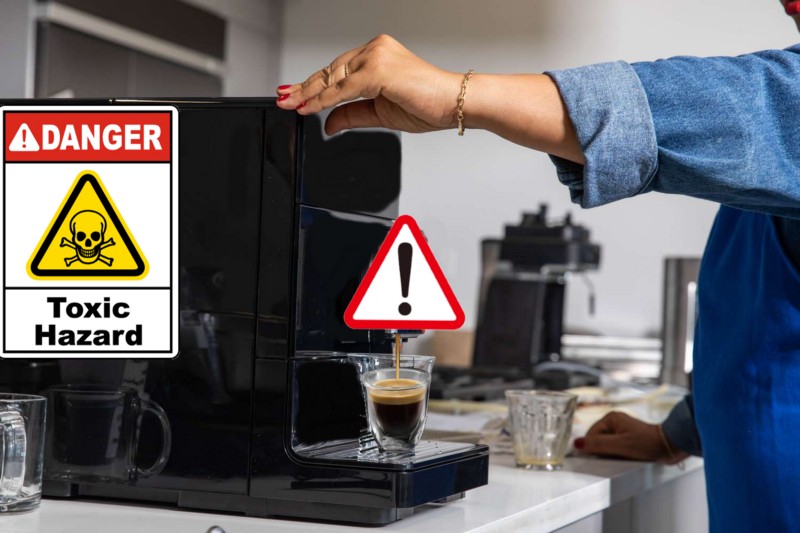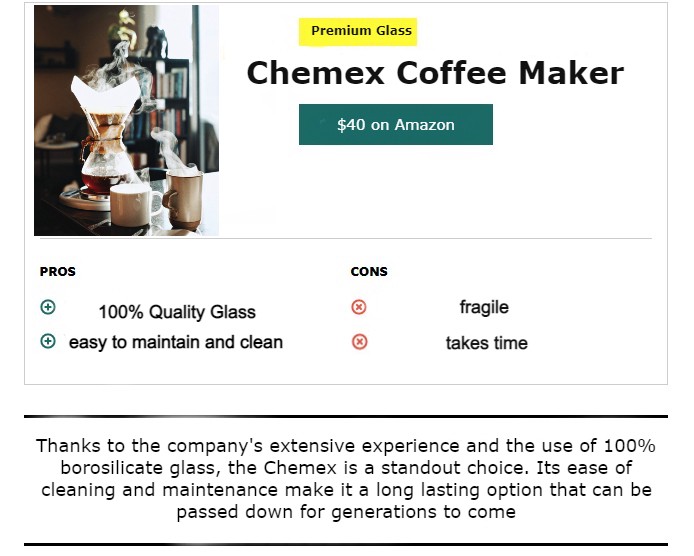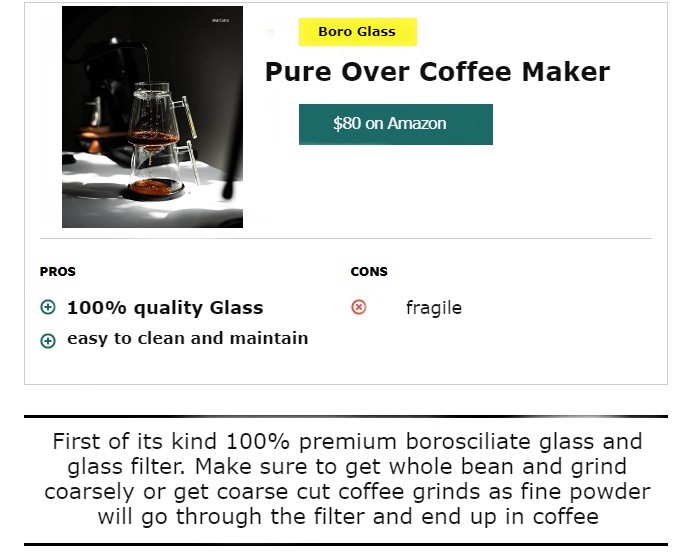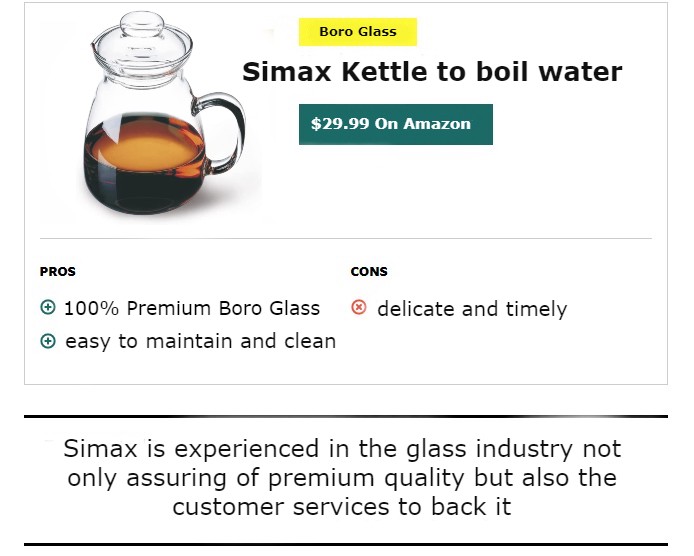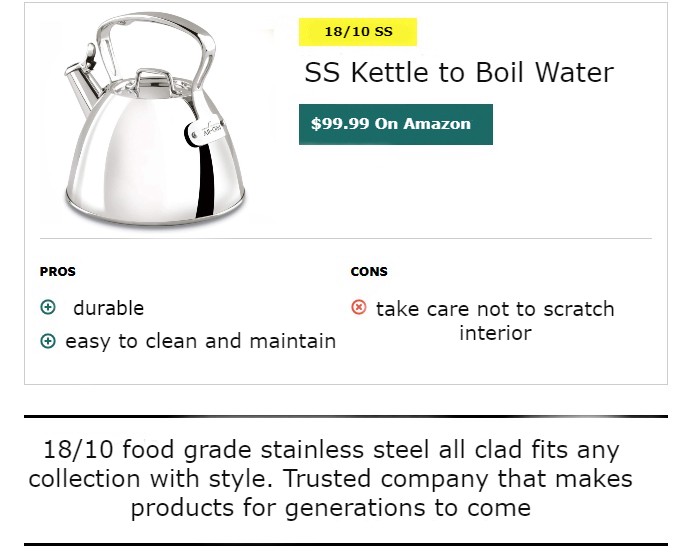Shaping a Better Future: Prioritizing Health and Wellness
The coffee industry is one of the largest and most complex agricultural industries in the world, with millions of farmers, traders, and roasters involved in the production and consumption of coffee. As the demand for coffee continues to rise, it’s important to consider what is being made to fill this demand. You may never think the coffee you make daily is the breeding ground for bacteria or untastely toxic additives.
In this blog, we will explore the dangers of conventional coffee-ware and how we can transition to more healthy, eco friendly alternatives. Below is a list comprised of 3 healthy, eco friendly coffee makers and 3 healthy eco water kettles to boil water so you can get an idea for a complete healthy set.
3 healthy, eco friendly coffee makers on the market today:
- Trusted Brand: Chemex Pour Over Glass Coffee Maker
- Economical: Agogo Pour Over Glass Coffee Maker
- 100% glass coffee maker with glass filter: Pure Over Glass Coffee Maker
3 healthy, eco friendly water kettles for boiling water:
- 100% Premium Glass Kettle: SIMAX Glass Water Kettle
- 18/10 Stainless Steel: All-Clad SS Water Kettle
- Economical 18/10 SS: FireMaple Antartic Water Kettle
Second to glass — Next in line for healthy, eco friendly coffee-ware: Stainless Steel. Great to always have one of these handy in general but also for emergencies. They are easy to store and very durable. 100 % Stainless steel and do not need a kettle or filters, these coffee makers bring everything you need to start and finish a brew, in one small set:
ALL-in-1 Stainless Steel Coffee-ware:
- 304 Stainless Steel: Mueller French Press
- 18/10 Stainless Steel: Bialetti Venus Expresso
At times, life gets so busy what is needed is the fastest alternative between having a quick, safe cup of coffee without sacrificing much on quality; Stainless steel will be the one that will fit this void. These are some suggestions to help understand the content given and to give ideas on what to look for. By the end of this article, you will be able to consciously make an educated decision when you buy your next coffee maker.
Glass is made from natural materials such as: sand, soda ash, and limestone which can be recycled endlessly without losing its quality. Glass is also a non-porous material, which means that it doesn’t absorb odors or flavors like plastic or metal can.
Glass will not affect the coffee in any way ensuring that your coffee will always taste fresh and pure. It is also a great heat insulator which helps in keeping the coffee hot for longer periods of time. Being recyclable and sustainable, when you buy 100% glass you’re not only reducing the amount of waste in landfills but also reducing the need for new resources to be extracted. Plastic coffee makers are not only difficult to recycle but also often end up in landfills. Metal coffee makers are not very easy to recycle and may have a negative impact on the environment during the production. Ceramic coffee makers are not as eco-friendly and are fragile leading to more waste.
Even more, plastic can release chemicals into finished product when heated, which is a potential health concern. Same with some types of metal cookware, which can release metal ions when heated, especially if the cookware is scratched or damaged. Stainless steel cookware is considered to be a safer alternative as it is less likely to react with food and does not release any harmful metal ions. However, it’s important to note that even stainless steel can react with acidic foods, such as tomatoes, and can discolor or affect the taste of finished product. With coffee being about the same acidity, we would recommend using stainless steel in just the first step of boiling water if you want the pure taste experience.
Plastic can release chemicals when heated, which can be a potential health concern. Harmful chemicals such as Bisphenol A, Polyvinyl Chloride, Perfluorooctanoic acid, Phthalates and more:
Bisphenol is a chemical that is used in the making of certain types of plastic often used in food containers and water bottles. Studies have shown that Bisphenol can alter estrogen behavior in the body and has been traced to a variety of health problems, including- cancer, birth defects, and hormonal imbalances. Polyvinyl Chloride is a plastic commonly in food packaging, plastic wraps, and other household items. Polyvinyl Chloride can release harmful chemicals called dioxins when heated, which can be harmful to human health. Phthalates are a group of chemicals used to make plastics more flexible. Studies have linked Phthalates and plasticizers to a variety of health problems, including cancer, birth defects, and hormonal imbalances. Therefore, it’s important to be conscious of the type of plastic cookware you use and to avoid using it at high temperatures.
Perfluorooctanoic acid is used in the making of plastic materials, mainly during the production of waterproof fabrics or nonstick cookware. This is a very dangerous toxin that is persistent, toxic, accumulates in the body of humans. Thus, safe levels of exposure cannot be established, emissions should be minimized. Recently been linked to several health concerns in humans.
Some metal cookware can release metal ions when heated, especially if the cookware is scratched or damaged. For example, aluminum cookware can release aluminum ions when heated, which can be a potential health concern. Similarly, copper cookware can release copper ions, which can be harmful if consumed in large quantities.
Even more, metal cookware which are coated with non-stick coating, like Teflon, release toxic chemicals at high temperature. These chemicals are harmful to both humans and the environment. Thats why it’s important to be aware of the type of metal cookware you use and to avoid using it at high temperatures, or if it’s scratched or damaged. It’s also important to read the manufacturer’s instructions and use the cookware appropriately to avoid damaging your health.
Sometimes simple, is better; sacrificing quality for dash made instant coffee will always lead to subpar finished brew. The time saved from electric instant coffee makers will be left having to clean the coffee maker on a later date to properly maintain the unit.
The National Sanitation Foundation International completed a study in 2011, that found half of the coffee reservoirs that they tested, contained mold and yeast. According to NSFI, the study showed that the highest concentrations of contaminants in the average American household, could be found in the kitchen; with the coffee maker making it in top 5, along with faucets and pet bowls.
This can lead to infections or allergic reactions, according to the U.S. Food and Drug Administration. Coffee makers, including electric ones, can harbor bacteria if they are not properly cleaned and maintained regularly. The warm and moist environment inside as well as the presence of organic material such as coffee grounds can create the perfect conditions for bacteria to proliferate.
One of the main areas where bacteria can grow in a coffee maker is the water reservoir. The reservoir is in contact with water, and if not cleaned regularly, can is the perfect breeding grounds for bacteria. Bacteria can multiply rapidly in this environment of the reservoir, and can then be transferred to the coffee as it is brewed. Another area where bacteria can grow is in the tubing and hoses of the coffee maker. These parts can become clogged with coffee oils and minerals, which can create an infestation of bacteria. Additionally, the coffee pot and filter basket, if not cleaned properly, can also harbor bacteria and mold, which can affect the taste and quality of the coffee.
It’s important to note that choosing coffee-ware is just one small step towards a more healthy and sustainable lifestyle, but it’s a big step in the right direction. There are many other ways to improve health and be eco-friendly with just coffee; such as sourcing organic and fair trade coffee, organic paper/cloth filters, using clean filtered water, and composting coffee grounds. Clean water is just as important as this entire article is: to the coffee experience. Every step of the way, by doing research and making informed choices, we can all play a part in creating a more quality, health oriented coffee industry for all.
In conclusion, these are the dangers of conventional coffee makers and how they can harm health. As we become more aware for better, safer alternatives with products that you and the family can use on a daily basis. We provided suggestions to get you started on your search and to give you ideas to find the right coffee maker for all; A eco friendly alternative but also healthy, reducing environmental impact, and all to end with a better taste and quality in your cup of coffee. With more in depth studies to be done, we can continue to learn and make the best educated decisions for cookware for you and your family.
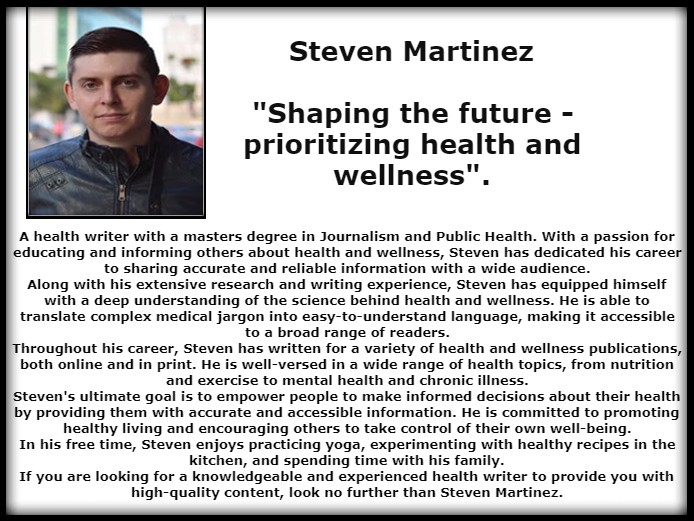
Sources: Information in this blog post was gathered from different peer reviewed journals and articles below:
PTFE-coated non-stick cookware and toxicity concerns: a perspective, Environmental science and pollution research international, 2017, Vol.24 (30), p.23436–23440
PFOA
Basini, Giuseppina et al. “Perfluorooctanoic Acid (PFOA) Induces Redox Status Disruption in Swine Granulosa Cells.” Veterinary sciences 9.6 (2022): 254–. Web.
Investigation of aluminum contamination from cookware
Yadav, Priya et al. “Selective and Sensitive Investigation of Aluminium Contamination from Cookware Based on Novel Water-Soluble Fluorescence Turn-on Chemosensor.” Journal of molecular liquids 362 (2022): 119777–. Web.
Tin lined copper cookware
Banavi, Parvaneh et al. “Release Behavior of Metals from Tin-Lined Copper Cookware into Food Simulants During Cooking and Cold Storage.” Environmental science and pollution research international 27.31 (2020): 38591–38601. Web.
The effect of water boiled in aluminum
Seyed Hosseini, Seyedeh Niloofar, and Zahra Zendehboodi. “The Effect of the Water Boiled in Aluminum Cookware on Chromatid Breaks in Human Blood Lymphocytes.” International journal of basic science in medicine 6.2 (2021): 42–43. Web.
Stainless Steel Clad Interactions in Cookware
Cho, Young-Rae. “Clad Metals: Fabrication, Properties, and Applications.” Metals (Basel ) 11.8 (2021): 1186–. Web.
Stainless Steel 304 corrosion behavior
Stroosnijder, M.F, and V.A.C Haanappel. “Influence of Mechanical Deformation on the Corrosion Behavior of AISI 304 Stainless Steel Obtained from Cooking Utensils.” Corrosion (Houston, Tex.) 57.6 (2001): 557–565. Web.


